|
The Methodist Church evolved from the Wesleyans. The town's original Wesleyan Chapel was at 149 High Street on land purchased from Thomas Somerley. It was built by the Wesleyans and opened for worship in about 1835 (see below). Over the years the congregation fell away, the chapel had to be closed and sold in 1873 due to financial difficulties. The property was then converted into two cottages. At this time a small group of Wesleyans met together in houses, including one in Britannia Cottages, Cranford Road (see below). Also, prior to the building of their new chapel, the Wesleyans met in a room belonging to Mr. Charles Barlow at The Cross (see below). They remained there until their new chapel was built in Duke Street by Mr Coltman of Kettering in 1890 and opened for worship on the 25 November of that year. This date is on the five so-called Foundation Stones on the front face which were placed there by persons holding office in the Kettering Methodist Circuit. They show the date of 1890 together with each persons' name and other details. Soon after this date they became known as Wesleyan Methodists. School rooms were added in 1930.
|
Northampton Mercury 31 October 1890
OPENING OF NEW WESLEYAN CHAPEL
For many years past the Wesleyan cause has been carried on in the village, first in a room now occupied by the Boot and Shoe Society, behind Mr. Ayre’s shop (see below), and then a long room upon the premises of Mr. C. Barlow (see below) was fitted up and used by the Wesleyans as a mission room until quite recently, when that was wanted to extend the factory accommodation of Messrs. Hart and Levy, and since then the services have been held in cottages. Last year, a piece of land was purchased at a cost of £51 4s., and efforts were put forward to build a chapel. A large number of friends at Kettering and in the surrounding villages volunteered to help, some in the form of subscriptions and some in the shape of labour. Mr. T. Simpson, Manor House, Pytchley, and Mr. Riggall of Barton Seagrave Lodge, promised to draw the material gratis; Mr. Saunders, of Kettering, architect, drew up the plans; and Mr. S. Coltman. Builder, and Jessopp, carpenter, both prominent Wesleyans, were entrusted to carry out the work, the contract being £360, so that including the price paid for the land the total cost will be about £411, and according to the financial statement made at the evening meeting about £140 is required before the building is paid for. As several grants are expected, this amount will be considerably reduced. The chapel is comfortable and commodious, being brick-built and slated, the frontage to Duke-street being built with pressed brick. It is 30ft. by 40ft., lofty, and well lighted. The floor is of wooden brick, and there is also a raised platform and rostrum, for the use of which Mr. Stuffins, of Kettering, has presented a Bible, and Mrs. T. Simpson, of Pytchley, a hymn book. There is also a snug and cosy little vestry, and also the necessary out-buildings. Saturday was fixed for the opening ceremony, and although the weather was very unpropitious, a good number of friends were present from Kettering, Pytchley, and other neighbouring places. A service was held in the chapel in the afternoon, when the Rev. Ebenezer Moulton, Chairman of the Bedford and Northampton district, preached a very impressive and appropriate sermon.
This was followed by a public tea in the Baptist Assembly-room, when about 160 sat down. The ladies connected with the Wesleyan cause, presided at the tables, and these were helped by other ladies, whilst Messrs. G. Thompson, T. Bassford, G. Minney, G. Capps, and other willing helpers found plenty of work in supplying the needs of all. Subsequently, a public meeting was held in the new Chapel, presided over by Mr. Charles Sanders, of Kettering.
|
|
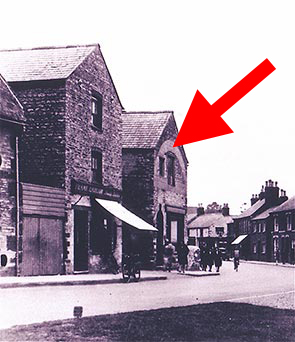 |
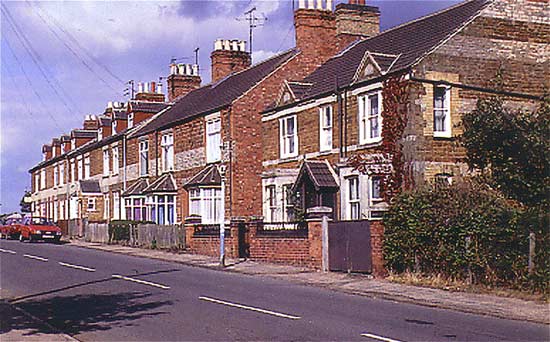 |
|
Barlow's premises showing room above
|
Brittania Cottages, Cranford Road
|
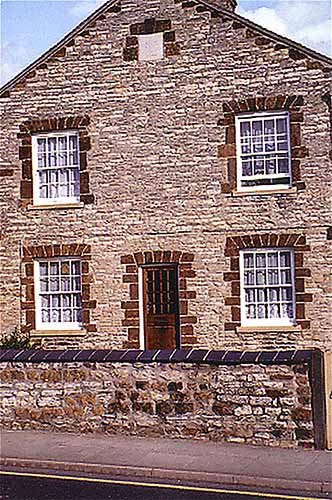 |
 |
|
Original Wesleyan Chapel 149 High Street
|
Mr. Ayres' shop, Kettering Rd., (later Gilby's) with the long room at the rear used for Wesleyan services before the chapel was built
|
Extracts from the Wellingborough News 13 January 1883
Burton Latimer Opening of a New Wesleyan Preaching Room
On Sunday last two sermons were preached by Mr W J Underwood of Richmond College in connection with the opening of a new preaching room in the village. In the afternoon the sermon was based on Roman viii, 27, and in the evening the text chosen was 1 John 1.9. At the afternoon service there were 116 people present, and in the evening the attendance rose to 130. The collections amounted to £1.13s. Since Sunday special meetings have been conducted by Mr and Mrs Smith, "the converted gypsies." There have been good attendances.
Burton Latimer Special Services
Mr and Mrs Smith, the converted gypsies, have the past week been labouring among the Wesleyan society at this place, and as a result of their efforts about 30 people made profession of their personal faith in Christ. The room was crowded every night with very attentive hearers and many went away deeply impressed. Mrs Smith is an excellent singer, and used her voice with great advantage during the services.
From the Wellingborough News 31 March 1883
Burton Latimer Wesleyan Preaching Room
On Good Friday, March 23rd, a public tea was provided, in the above place, when about one hundred and fifty sat down. After tea a lecture was delivered by Mr Chambers, of Kettering, subject "Our local preachers." A collection was made to reduce the remaining debt.
Extract from the Kettering Leader and Observer June 1895
Anniversary Services at Burton Latimer
The Burton Latimer Wesleyan Chapel anniversary was celebrated on Saturday and Sunday. A public tea and meeting were held on Saturday. At the evening meeting Mr T Collings occupied the chair, and in introducing the first speaker, the Rev E S Thies (Superintendent of the circuit), he referred to a letter received from the Rector (Rev W B Jacques) on the subject of appointing three Nonconformists as managers of the day schools. He said that that was the first occasion he had had since receiving the letter to meet the Wesleyans of the village and to explain the grounds on which they felt unable to accept the invitation. The trust deeds of the school required that the teachers should be members of the Church of England, and also that those appointing them should belong to the Church of England. If therefore Nonconformists accepted a position on the Board of Management they would have no vote on the most important matter of the engagement or dismissal of teachers. While therefore they warmly appreciated the Rector's courtesy and goodwill they could not accept a position in which they would have no real power. He offered this explanation as he thought it very important that the various bodies of Nonconformists in the parish should be heartily united on these public questions - Rev E S Thies said that he heartily concurred in the action taken by the Baptist trustees, and was sure that the same view should be taken by all present. He reciprocated the remarks of the chairman as to the importance of unity, and also urged that they should maintain a spirit of aggression among them. He regretted that the debt of £60 on the chapel had not been reduced during the last year, but no doubt some thing would be done in this direction in the near future. The Rev H Hooper also spoke and gave some interesting reminiscences of his past work. After lamenting the prevalence of indifferentism in village life, the reverend gentleman urged that they should be earnest and devoted in seeking to win others for Christ. He also dwelt on the need for a greater spirit of reverence in places of worship, and concluded by entreating the young people to cultivate that spirit. Solos were given during the evening by Edith Capps and Mrs Bunyan and the choir sang the "Children's hosanna." - On Sunday the Rev I Armstrong preached special sermons to rather limited congregations. The collections were in aid of the chapel fund.
In the early 1900s the Chapel interior was used as an overflow from the school in the High Street with three classes of older children using the room. A new infants school was built in 1908 and the building was then no longer required for this purpose. In appreciation the school authorities provided 15 pews which were fixed to the floor.
Stone-Laying of Wesleyan Sunday School (from a newspaper article 24 October 1930)
Next in importance to the erection of a new church in the life of a town comes the building of a new Sunday School. On Saturday the first stones were laid of a Wesleyan Sunday School at Bur ton Latimer, and the significance of the occasion was recognised by the presence of the other Free Church ministers of the district and of the Rector of the parish, the Rev A T Edwards, and of a large and enthusiastic gathering of townspeople.
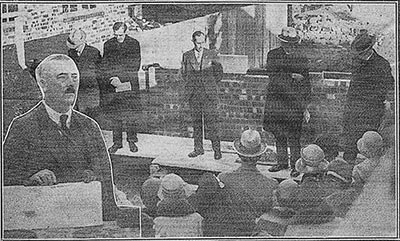 |
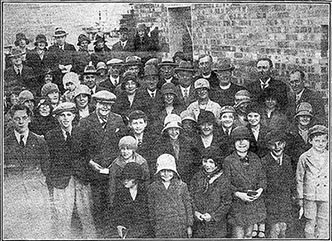 |
|
The Rev H Graham Payn, (former Superintendent of the Circuit,) speaking. On his right are Mr C A Bugby (who laid a stone on behalf of the Sunday School teachers), and the Rector of Burton Latimer, and on his left is seen the Rev W Jackson Bush of Kettering. Inset: Mr A G Miller, C.C., laying a stone.
|
This photograph shows the twenty pupils who each laid a brick of their new school. The bricks had the initials of the layers carved upon them.
|
The following extracts are taken from a newspaper article:
Appropriately, on the eve of Young People's Day, the stone-laying ceremony of the new Sunday School connected with the Wesleyan Church at Burton Latimer took place on Saturday afternoon.
There was a large gathering of supporters of the Church and sympathisers to witness this very important step towards realising the hopes of the enthusiastic promoters of the erection of the Sunday School building. The Rev W Jackson Bush of Kettering, presided.
FOUNDATION OF GOOD LIFE
Prior to the ceremony, the Rev H Graham Payn, former superintendent of the Circuit, addressed the gathering, and said that he appreciated very highly the invitation to be present. He had had a very happy ministry in the Circuit, and he often wished that he was back in it.
He could not be many years in Burton Latimer without knowing of the desire on their part to build a school. Abraham Lincoln had said that the Bible and the Sunday School and the public school were the bulwark of the land.
Robert Raikes, the founder of the Sunday School movement, began with twelve children, and today there were 38,500,000 receiving instruction in the Word of God in the Sunday Schools. The speaker could not help imagining the stream of life going out into the world and leavening the life of the country.
He liked to think of the Sunday School as laying the foundation upon which the superstructure of a good life, it was hoped, would be built. He was sure that they all joined in wishing prosperity to the work of the Church and School, and rejoicing in the consummation of the present scheme.
HISTORY IN STONES
Stones were then declared to be well and truly laid by Mr W H Marriott, Circuit Steward, who has been a Sunday School teacher for 35 years; Mr C A Bugby, on behalf of the Sunday School teachers; Mr R B Pownall, chairman of the Burton Latimer Urban Council; Mr W Green, an old Church worker of 33 years' standing; Miss Edith Line, in memory of her father, the late Mr John Pywell Line; Mr F C Basford, in honour of his parents, Mr T Basford and the late Mrs Basford; and Miss Webb in honour of her father, Mr H Webb.
Twenty pupils of the School each laid a brick with his or her initials carved upon it.
The Rector (the Rev H T Edwards, M.A.), who pronounced the Benediction at the conclusion of the ceremony, said that he would watch the building go forward with a good deal of interest, and, on its completion, he hoped that it would bring numbers of people of Burton Latimer into salvation.
BEGINNING THE SABBATH
A tea was provided in the Baptist Assembly Hall by kind permission of the minister (the Rev J Robins) and the deacons, after which a public meeting was held in the Wesleyan Church. It was well attended, and was presided over by Mr A G Miller, C.C.
The principal speaker was the Rev Sherwin Smith, M.A., R.D., of Wellingborough (Chairman of the District) who said that he must congratulate the Church upon its timely move in laying the foundation stone.
The timeliness lay in the fact that it was a Saturday night. He liked the Jewish custom of beginning the Sabbath on the day before. Some of the Puritans had the same idea. The speaker had vivid memories of Saturday night. In his early days it was the night for the bath - (laughter) - when he went to bed fresh and clean and his underwear and good clothes laid out in readiness for the next day.
One of the glories of the Sunday School was that it was dealing with human material somewhat in the making. Perfection was not expected, but every boy and girl had aspirations which worked towards perfection.
There was a tremendous untutored and uneducated manifestation on the part of young men and women who wrestled for the sake of Christ, with the youth of the country. He hoped that in the school, of which the foundation stone had been laid, would continue the work which had been going on for about the last 150 years.
"LOSING THEIR HOLD"
In the days of Robert Raikes the times were changing. Parents were losing their hold on their children. Consequently the boys and girls were getting into a dreadful state, and were going down the slope. Robert Raikes found boys gambling and breaking the Sabbath, this bright and lovable soul was moved to start the meetings for boys and girls whence sprang the Sunday School.
Brief addresses wishing the Sunday School a prosperous future were also given by the Revs J Robins, W J Bush and J Wainwright Utley. Miss Gladys M Bush sang two solos.
A financial statement by Mr Bugby revealed that £148 2s. had been collected previously towards the cost of the building - namely, £450. A further sum of £74 2s. 10d. had been received that day in donations and collections, making a total of £222.4s. 10d.
OPENING OF THE WESLEYAN SUNDAY SCHOOL by MR S F PERRY, MP - FEBRUARY 1931
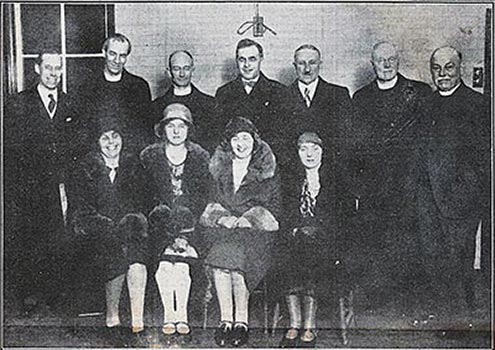 |
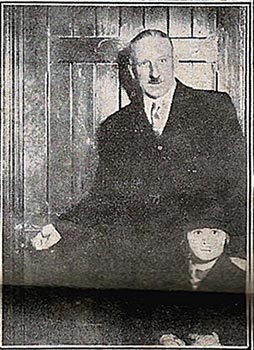 |
|
Back L to R: Mr C Bury (Sunday School Superintendent), Rev F John (Rothwell), Rev J W Wainwright Utley (Kettering), Mr A Marlow (Kettering), Mr S F Perry, M.P., Rev W Jackson Bush (Kettering),
W J Underwood (Kettering)..
Seated L to R: Miss E Mason (Primary teacher), Miss G M Bushy, who opened the Primary Room), Miss Constance Read and Mrs S F Perry
|
Mr S F Perry, M.P. unlocks the door of the new school with the silver key handed to him by Miss Rosemary Lewis
|
Extract from a newspaper article February 1931
Following upon the laying of the foundation stones of the Wesleyan Sunday School Hall and the Primary Room at Burton Latimer at the rear of the chapel last October, the next stage - that of officially declaring the rooms open - was reached last Saturday afternoon.
The importance of the occasion was reflected in the number of adherents and well-wishers of the other religious bodies in the town who assembled in the chapel. The gathering was presided over by the Rev W Jackson Bush, Superintendent of the Kettering Wesleyan Circuit, and the opening ceremony was performed by Mr S F Perry, M.P., who was accompanied by Mrs Perry.
Tribute to the enterprise of the people of Burton Latimer in carrying out the scheme of erecting the Sunday School and Primary Room was paid by Mr Bush, who also went on to refer to the excellent use of the available land made by Mr Lewis, the builder, of A P Lewis and Sons Ltd of Duke Street. The speaker said he was delighted to see Mr and Mrs Perry present.
In the absence of Mr Lewis, his little daughter handed a silver key to Mr Perry, who then turned the lock and declared the School Hall to be opened. The Primary Room was declared to be opened by Miss G M Bush.
RELIGIOUS CRISIS
"It is a great joy for us, at the first function in Kettering itself, to come to our Methodist friends and rejoice with them on their great day," said Mr Perry.
Within the last fourteen days, he continued, he had been present at what was undoubtedly a crisis in Parliamentary affairs. All who knew him would never accuse him of introducing politics in religious work, but the crisis to which he referred, and which took the mind back thirty years, was the religious teaching of the child.
"Far be it from me," said Mr Perry, "to say any word that would make a satisfactory settlement of the problem more difficult. But it was apparent to all who took part in . . . to those who had done him honour that afternoon.
FORMER SUNDAY SCHOOL TEACHER
As a former Sunday School teacher, he had become attached to the work. It was often a great joy to be able to discuss with the members of the class something of their future. The speaker referred to the responsibility which rested with the Sunday school teacher, and said that today there was a greater responsibility than ever by those connected with Noncomformist churches.
Despite the work and devotion of the people he wished to make an appeal for renewed energy in the great and noble work of teaching and guiding the children.
He also urged that the new hall and Primary room opened that day be used to its fullest extent and be made part and parcel of the life of the community. If they did not provide healthy recreation for young people they were driving them to find it in questionable surroundings.
In concluding, Mr Perry hoped that, great as the work had been in the past, it would be nothing to the glorious future lying before the Church.
SURPRISED MANY PEOPLE
The good wishes of the Kettering and District Sunday School Union were conveyed by the President, the Rev J Wainwright Utley. He congratulated Burton Latimer upon the good effort made. They had been faced with difficulties, yet they had laboured on, and had surprised many people by putting up a very fine Sunday school.
A solo "My Heart Ever Faithful," was sung by Mrs Harwood (Miss Constance Read).
Tea was provided later in the afternoon in the Baptist Assembly Hall by permission of the minister and deacons of that church.
EVENING MEETING
A public meeting in the Wesleyan Church which followed in the evening was well attended, and was presided over by Mr Arnold Marlow. With him were associated Mr S F Perry, the Rev W Jackson Bush, the Rev W J Underwood, the Rev Frederick John, the Rev J Robins and Captain Watkins C.A.
The Superintendent of the Sunday School, Mr C A Bugby, reported upon the finance of the school. The new building had been erected at a cost of £450.
 |
|
The interior of the church c1933
|
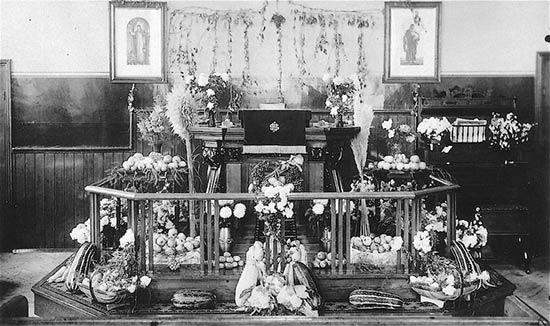 |
|
Harvest Festival c1950
|
Various changes have taken place since the early 1900's including updated heating and the installation of a pulpit which was brought from the Silver Street Methodist Church, Kettering when the new Central Methodist Church was built. (This pulpit was later replaced with a new pulpit to match the communion rail and table). Fixed pews were replaced with chairs in 1971 and a stained glass window was fitted in 1992.
In 1941 the school rooms were taken over by the Inns of Court regiment and other army units until they left in 1944. It was November 1946 before the rooms were redecorated and handed back for use. Large black curtains were fitted to the Chapel windows for the black-out during the period of the war; and times of services were altered as there were no buses on Sunday mornings.
A harmonium was used to provide music up to the 1930s when an organ was presented by Mrs Buckby, wife of a local boot and shoe manufacturer. This was fitted with pedals to provide the air for the sound, making hard work for the organist. In 1950 this was replaced with a Baby Grand piano which was used until 1969 when a small electronic organ was purchased. A piano was always available in the Church.
From 1999 the main entrance was established in Piggotts Lane and other facilities were added including a new pulpit. A new communion table was put in place in 2009.
During the 1920/1930's various concerts took place as can be seen in the following photographs.
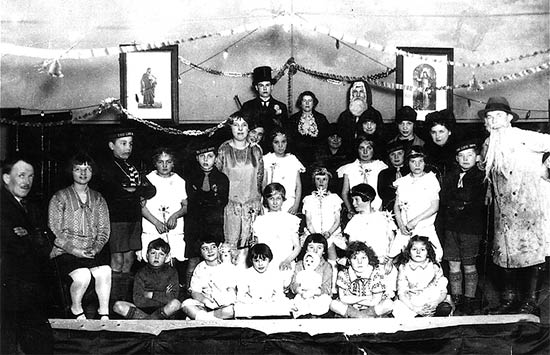 |
|
Christmas Concert 1920/1930s
|
 |
|
A performance of the play, Aunt Jemima's Visit - 1930
|
 |
 |
|
Poster and cast list for "Aunt Jemima's Visit"
|
 |
|
Burton Performers at Harrowden 28 March 1930
The operetta, "Redcap in Fairyland", performed by Burton Latimer Wesleyan Sunday School children at Little Harrowden Wesleyan Chapel.
|
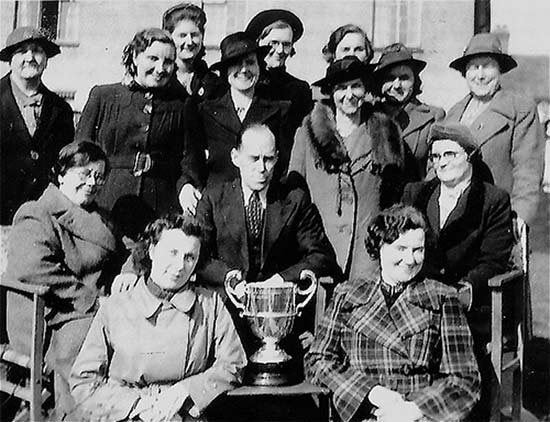 |
|
A group of fundraisers for The National Children's Home Methodist Church Charity - 1950s
L to R Standing: ?, Marge Mason, Joyce Cole, Annie Rowe, Dorothy Reynolds, ?, ?, Doreen Pentelow, Alice Capon
L to R Seated: Aggie Taylor, Arthur Bugby, Rose Randall
Front: Barbara York and Florence Tomlin
|
AN EARLY MEMORY FROM MR ALBERT TAILBY
"In boyhood days we attended morning workshop at 10.20, Sunday School at 2 o'clock and for the adults, evening service at 6 o'clock.
I "remember how very strict things were then. In the morning if you turned to whisper to your friend, a steward would quietly come behind and the first thing you knew was the contact of a hymn book on the top of your head.
"Once we had a temperance visitor. I was 8 years old. After his talk we were ordered to the front and instructed to sign the Pledge. Not being prepared to do this without time to consider, I escaped by hiding behind a pew at the rear of the Chapel."
NAMES OF SOME OF THOSE CONNECTED WITH THE CHAPEL IN THE PAST
John Toseland; Mr and Mrs Harry Webb and their granddaughter, Evelyn; Annie and Arthur Bugby; William Green (who played the organ); Thomas Charles Webb Basford and his son, Frank; Mr and Mrs Ball (caretakers); Mrs Bates; Miss Florrie Panther; Rose and Walter Pell; Mr and Mrs Bull; Miss Eva Rhymill; Mr and Mrs Wood; Harry and Mrs Cole; Edie Mason (Mrs Cleaver); Reg Cooper, Wilfred and Leslie Labrum, Phyllis Panter; Joe Hewitt; Mr and Mrs Hicks (Mrs Hicks was an organist and a soloist); Miss Alice Capon (headmistress at the infants school and in charge of the Sunday School; John Butlin (Sunday School superintendent and local preacher) and his son, Harry; Isaac Coles and Mrs Coles (friends of Elizabeth Fry, the prison reformer); Mr Pentelow (headmaster of the junior school) and Mrs Pentelow; Mrs Green; Mrs Smith.
|
















